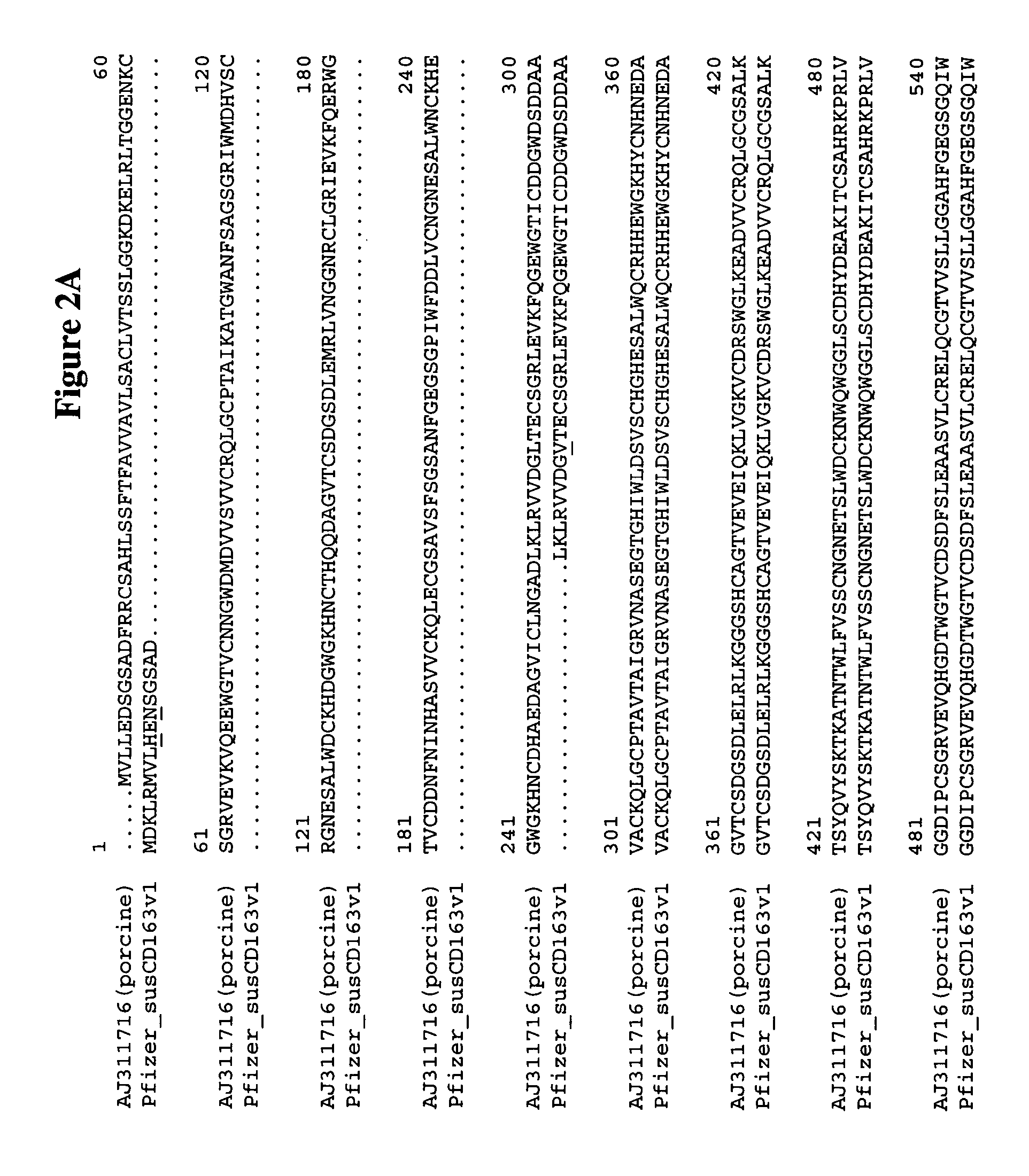Cellular permissivity factor for viruses and uses thereof
a technology of permissive factor and virus, which is applied in the field of cell permissivity factor for viruses, can solve the problems of insufficient transfection with sialoadhesin, potentially dangerous activity, and inability to tolerate cell lines, and achieve the effect of increasing the expression of a cd163 polypeptide and facilitating the infection of one or more cells
- Summary
- Abstract
- Description
- Claims
- Application Information
AI Technical Summary
Benefits of technology
Problems solved by technology
Method used
Image
Examples
example 1
[0523]Transient transfection with porcine CD163 confers permissivity to PRRS virus infection to a non-permissive cell line. Total mRNA from primary porcine alveolar macrophage cells was used to construct a cDNA library in the plasmid pCMV-Sport6.1 (Invitrogen), with the cDNA cloned between the EcoRV and NotI sites. A member of this library, when isolated and transiently transfected into the BHK-21 (baby hamster kidney) cell line, conferred a PRRS-permissive phenotype. Cells were grown in Dulbecco's modified Eagle medium (DMEM) supplemented with 5% fetal bovine serum (FBS) in a 5% CO2 atmosphere at 37° C. Cell cultures were transiently transfected using 10.0 uL of Lipofectamine 2000 (Invitrogen) and 2.0 ug of plasmid. A duplicate monolayer was transfected with negative control plasmid pPAMB. This plasmid is pCMV-Sport6.1 lacking an insert. Transfection efficiency was monitored with a plasmid expressing green fluorescent protein (GFP). Approximately 24 hours post-transfection, monolay...
example 2
Construction of Plasmid pCMVsusCD163v1
[0527]Construction of the plasmid pCMVsusCD163v1 was performed as follows. The functional clone identified in the primary porcine macrophage cDNA library as conferring PRRSV permissivity served as template for PCR amplification of the CD163 insert, including the 5′ and 3′ untranslated regions, using the primers 5′DS-CD 163 (SEQ ID NO: 6) (5′-CGGAATTCCGCGGATGTAATAATACAAGAAGA-3′) and 3′CD163 (SEQ ID NO:7) (5′CCGCTCGAGTAGTCCAGGTCTTCATCAAGGTATCTT-3′). Primer 5′DS-CD163 incorporates a SacII restriction site at the 5′ end of the CD163 insert, while primer 3′CD163 incorporates an XhoI restriction site at the 3′ end of the insert (underlined). Reactions containing 190 ng of plasmid template were amplified using Platinum Pfx DNA polymerase (Invitrogen cat # 11708-013) following the manufacture's instructions. Reactions were heated to 94° for 2 minutes then cycled 35 times through 94° for 20 seconds, 55° for 30 seconds, and 68° for 3.5 minutes followed by...
example 3
Construction of the pRSV-Script Expression Vector and pRSVsusCD163v1
[0528]The plasmid pRc / RSV (Invitrogen) was used as a template for PCR amplification of the RSV promoter. RSV promoter sequence was contained within nucleotides 209 through 604 of pRc / RSV. Forward primer PCIRSVLTR (SEQ ID NO:8) (5′-ACACTCGACATGTCGATGTACGGGCCAGATATACGCGT-3′) and reverse primer VSRRTLSAC (SEQ ID NO: 9) (5′TTCCTTACAGAGCTCGAGGTGCACACCAATGTGGTGAA-3′) were synthesized. Restriction endonuclease Pci I and Sac I recognition sites (underlined) were incorporated into the 5′ and 3′ primers, respectively, for future cloning. PCR was performed using the HotMaster Taq DNA Polymerase kit (Eppendorf) following the manufacturer's instructions. The reactions contained 0.9 ng of pRc / RSV plasmid template and 0.3 μM of each primer described above. The reactions were heated to 94° for 2 minutes then cycled 30 times through 94° for 20 seconds, 52° for 10 seconds, and 65° for 1 minute. The resulting PCR fragment was digested...
PUM
 Login to View More
Login to View More Abstract
Description
Claims
Application Information
 Login to View More
Login to View More - R&D
- Intellectual Property
- Life Sciences
- Materials
- Tech Scout
- Unparalleled Data Quality
- Higher Quality Content
- 60% Fewer Hallucinations
Browse by: Latest US Patents, China's latest patents, Technical Efficacy Thesaurus, Application Domain, Technology Topic, Popular Technical Reports.
© 2025 PatSnap. All rights reserved.Legal|Privacy policy|Modern Slavery Act Transparency Statement|Sitemap|About US| Contact US: help@patsnap.com



